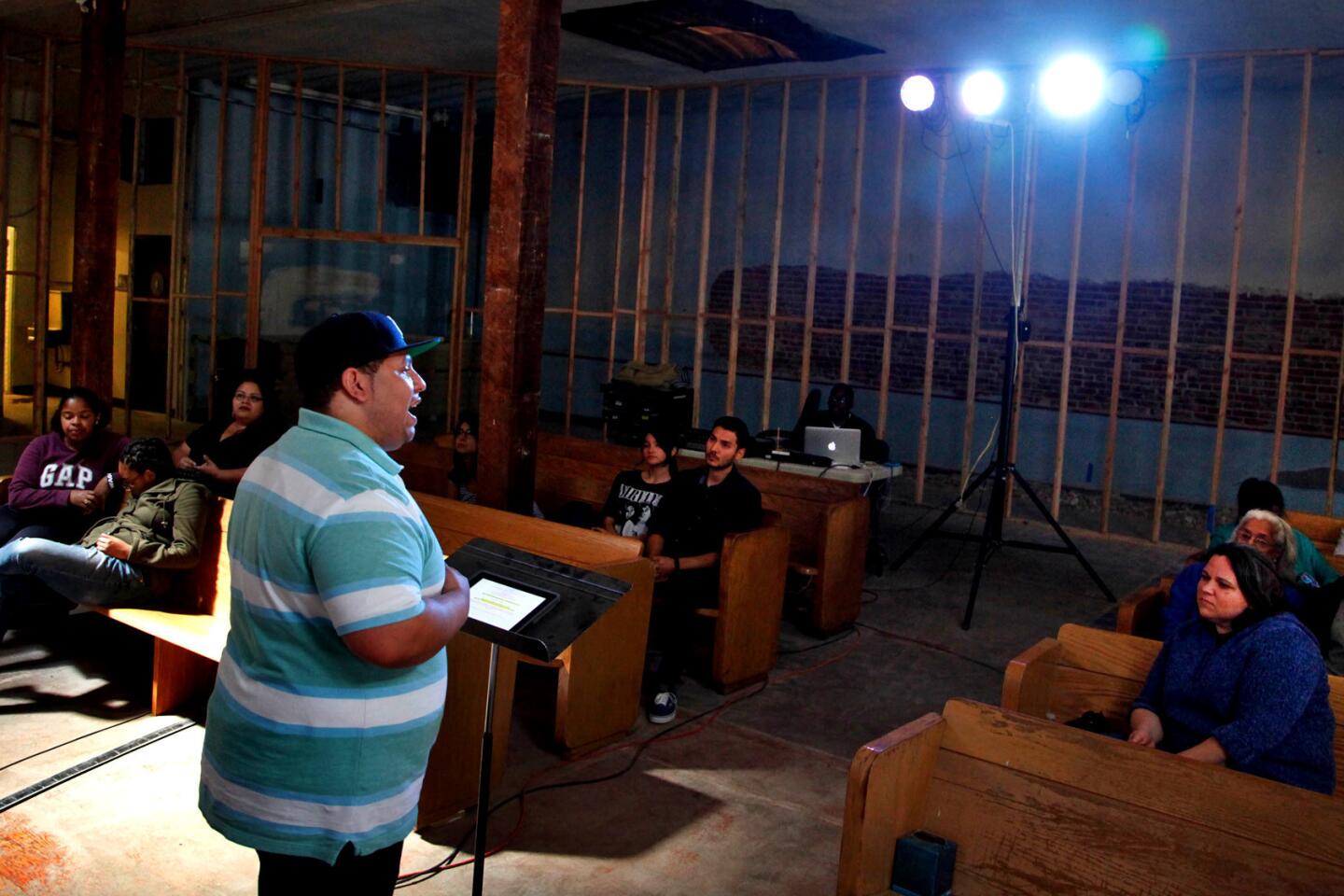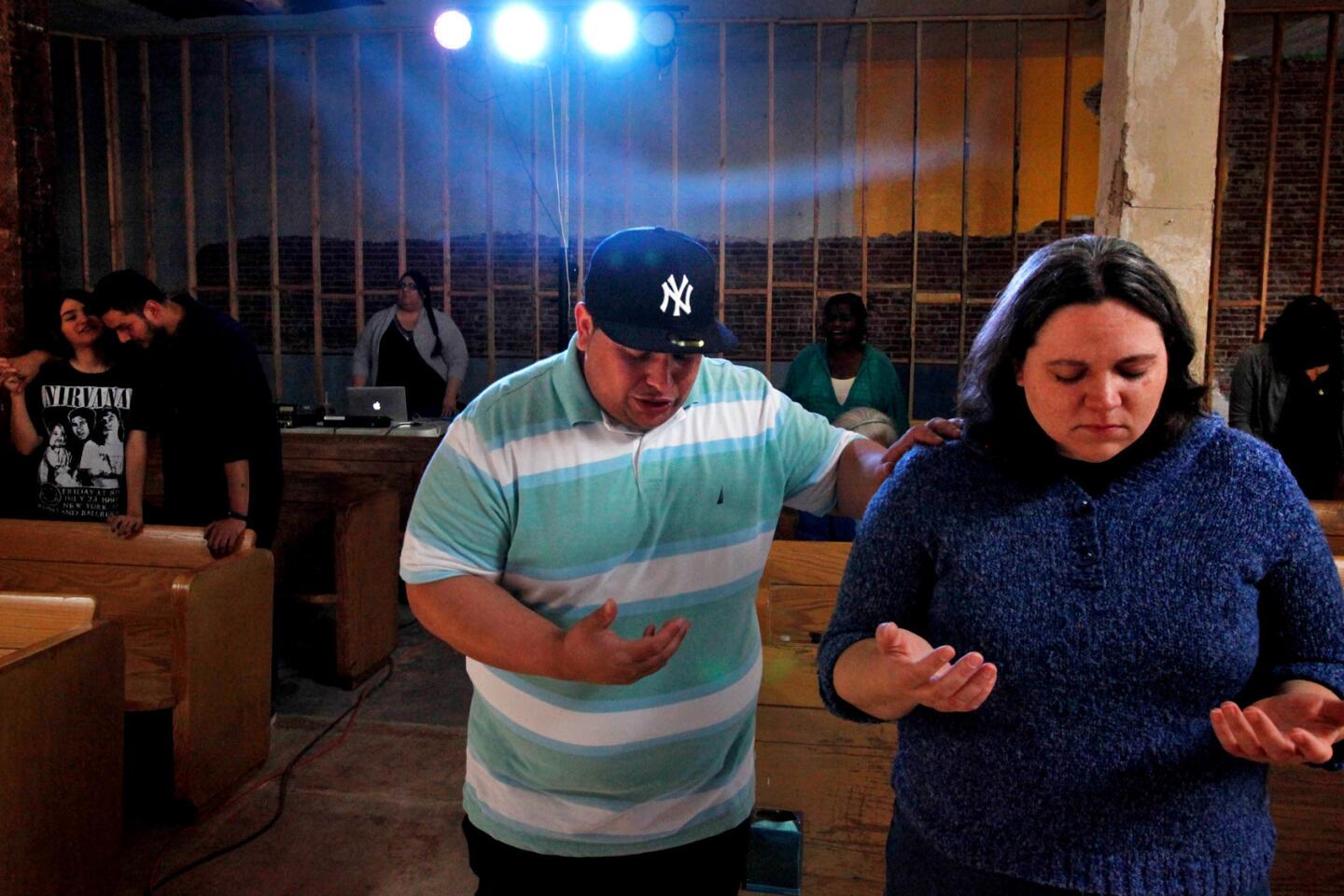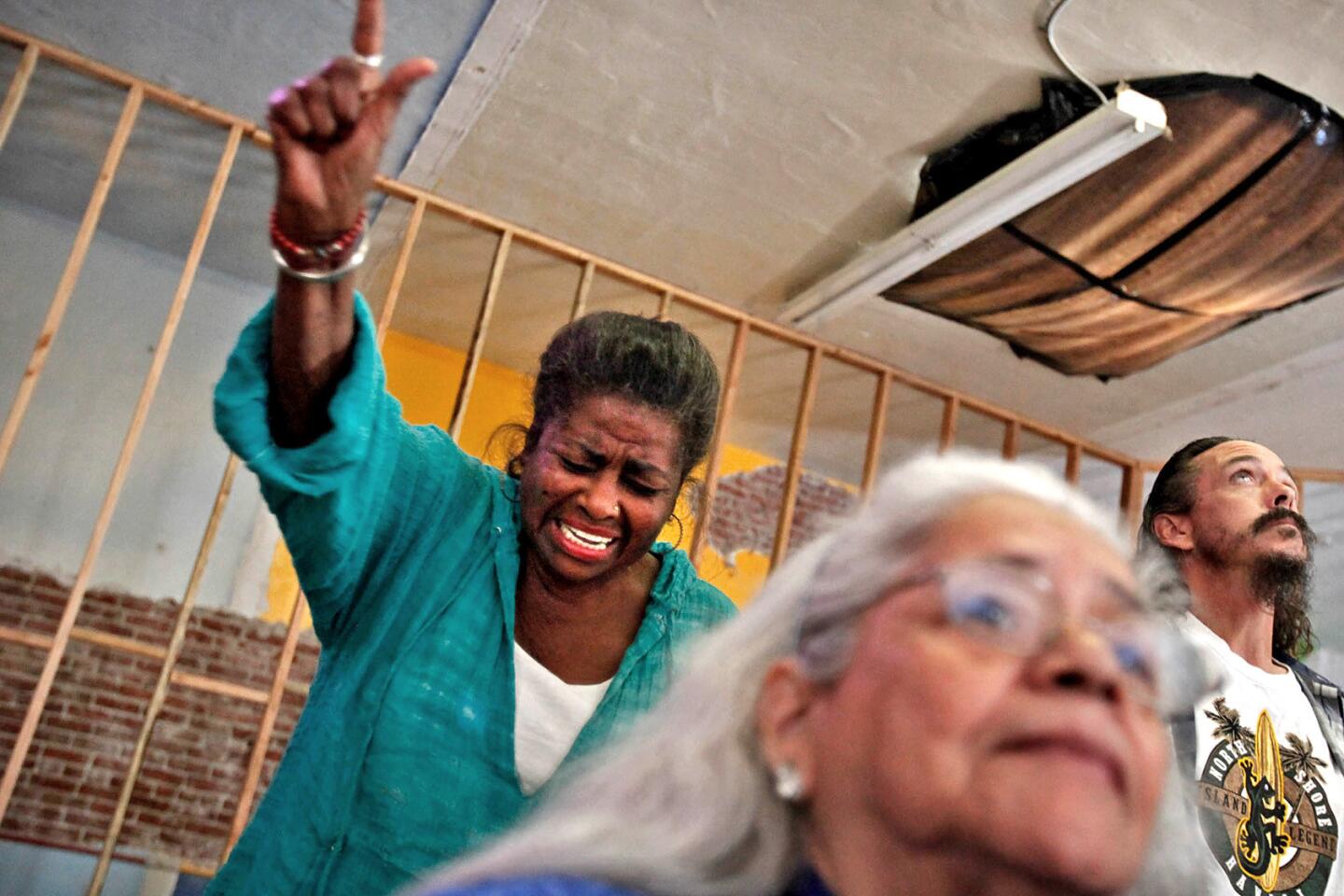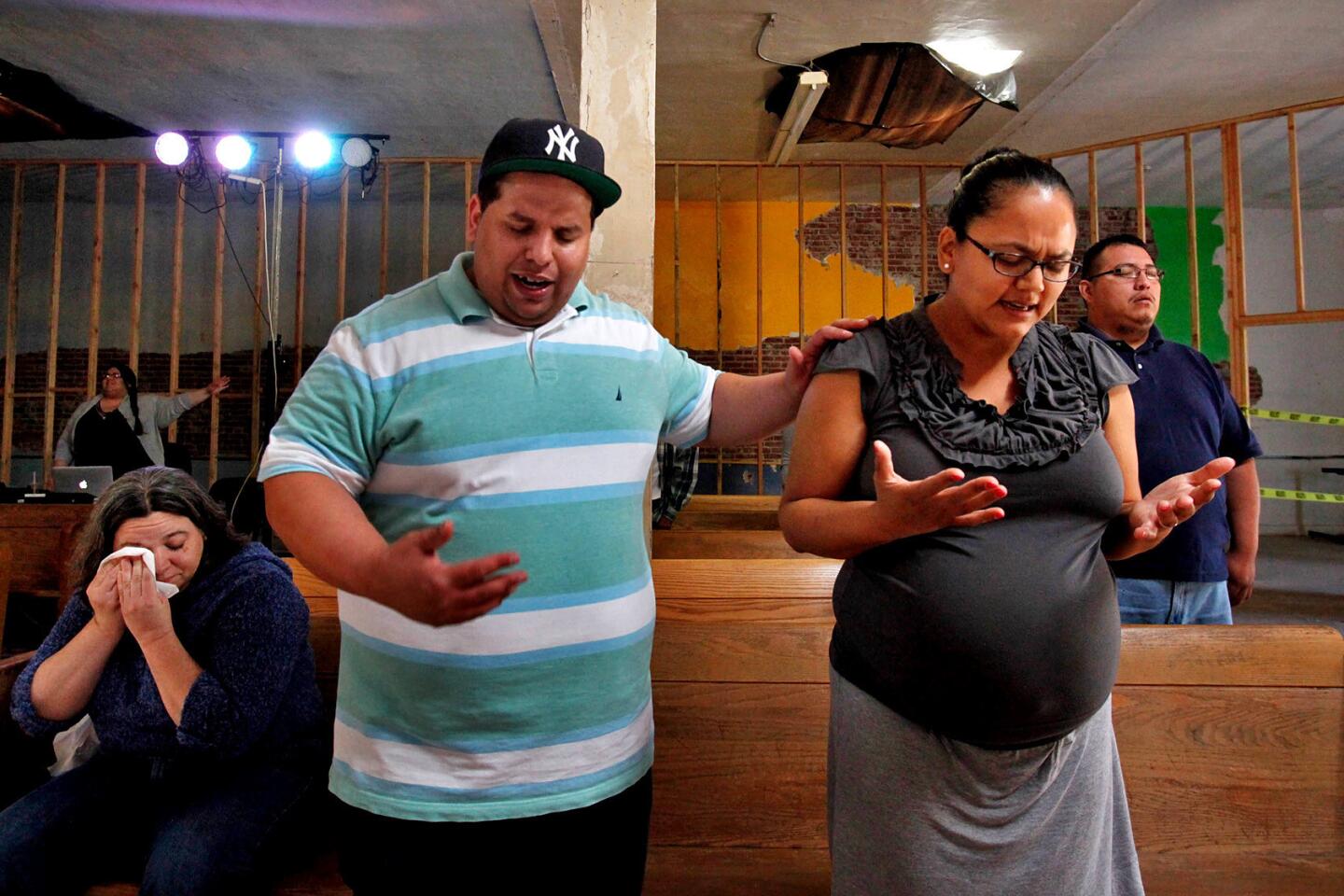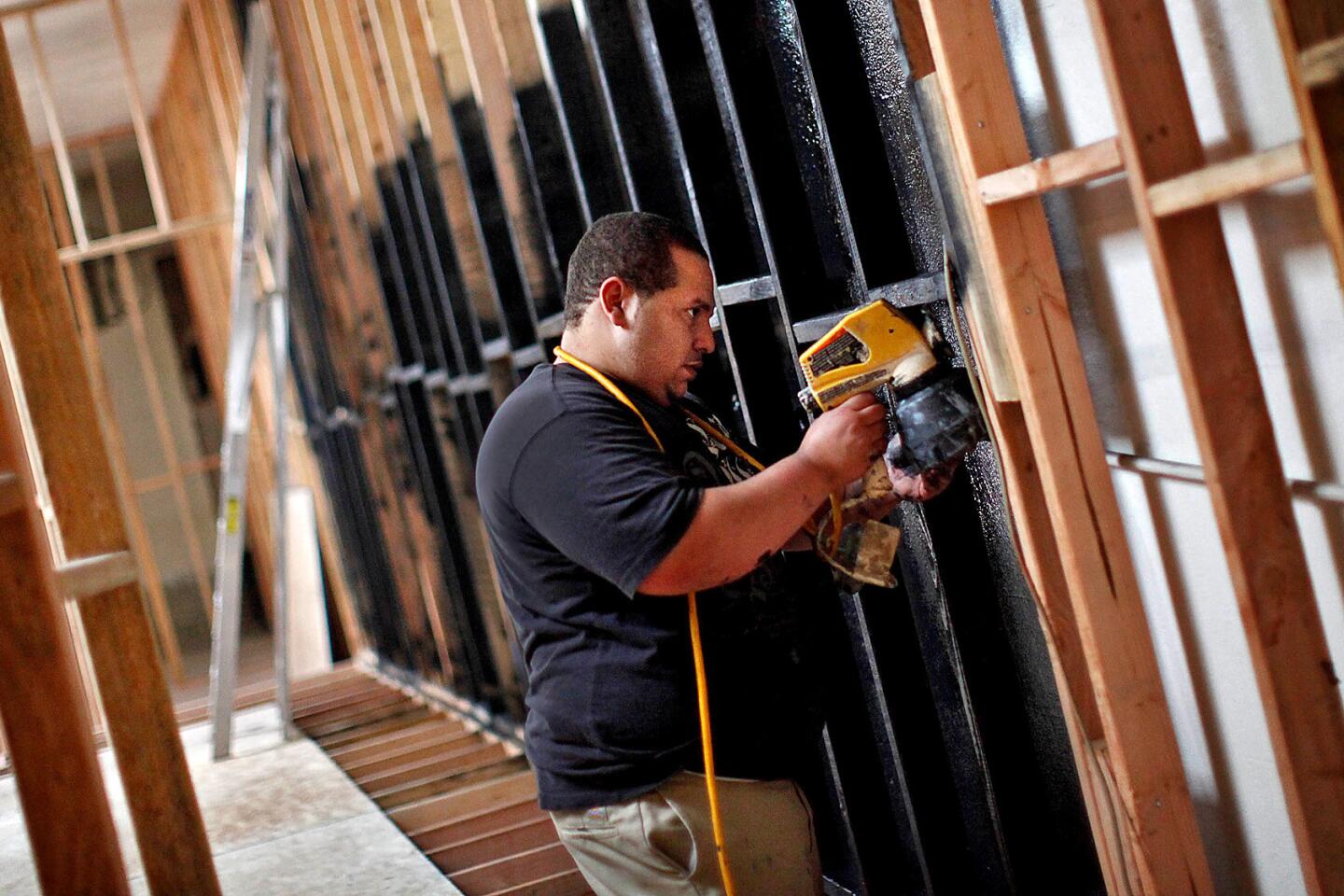Great Read: Eastside church is changing in a ‘post-gang era’
- Share via
Pastor Pete Bradford, a reformed “dope fiend” from San Diego, went out into the streets of Boyle Heights looking for gang members to pray over. Finding them wasn’t hard.
It was the early 1990s, the era of “Boyz n the Hood” and “Colors” and gangsta rap. Everything about gang life in Los Angeles was loud: the jagged slashes of graffiti, the thrum of police helicopters, the percussion of gun blasts.
Bradford, who said God had called him to L.A.’s Eastside, opened the Boyle Heights Christian Center in a low-slung building on 1st Street. The Pentecostal church became known as a house of worship for gang members, drug addicts and lost souls.
“It was not unusual to hear gunshots every day,” recalled Bradford, 66, who decided to retire last spring when Parkinson’s disease made it difficult to control his body. “We had windows shot out. They weren’t shooting at us. They were shooting at each other.”
Now, the loudest sound isn’t gunshots, but the insistent, clattering roar of the Gold Line train that sometimes fuzzes out the sermons of Bradford’s young successor, Joey Oquendo. The streets where gang members once prowled are dotted with cafes, wine bars, community theaters, art galleries and bookstores.
On a recent morning, Oquendo hoisted drywall sheets into the church. Mounds of chipped wall lay beneath exposed brick. Black plastic bags covered ceiling vents. The pulpit was bounded by the two-by-four skeletons of walls laid bare.
The gang members who once made up the bulk of the parish are mostly gone, leaving a congregation that can number fewer than 20. Some of the old-timers thought the 29-year-old Oquendo — who was born in New York to Puerto Rican parents but grew up in San Bernardino — too young, too inexperienced, not battle-hardened enough.
Oquendo said if they want to come back, he’ll welcome them. But the church will be different, because the neighborhood is different.
“There’s members who have been here forever, but in essence, a new church is starting,” Oquendo said. “Gang members want better things too. But because of who I am, and because of who my members are, we’re going to get more of the post-gang era.”
When the reconstruction of the church is finished, Oquendo said, even the name won’t be the same.
::
Few neighborhoods influenced the way that gang members look, act and talk from New Mexico to El Salvador as much as the Eastside neighborhoods that include Boyle Heights. Some of the gangs went back to the Great Depression.
Even now, 34 gangs are squeezed into the 15-square-mile Hollenbeck area largely made up of Boyle Heights, Lincoln Heights and El Sereno. But when Bradford came to Boyle Heights, L.A.’s gangs were especially bold.
In each of the three years after Bradford arrived in 1990, there were more than 2,000 homicides in L.A. County. In 1992, the LAPD’s Hollenbeck Division, which patrols Boyle Heights, had 86 killings, most of them gang-related. Father Gregory Boyle, the founder of Homeboy Industries, called the years from 1988 to 1998 “the decade of death.”
“One summer, someone died like for a month straight, every weekend,” said Charles Williams, 36, a drummer in the church band who joined when he was 15. “You couldn’t play basketball because they were shooting at the backboards.”
When Oquendo arrived, in 2013, L.A. County had 592 homicides, about a quarter as many as when Bradford began. Hollenbeck recorded just 14 homicides last year — a sharper decrease than the rest of the county.
“The reputation of Boyle Heights to me was pretty much ‘American Me,’ you know, ‘Blood In, Blood Out,’” Oquendo said, referring to movies about Eastside street gangs. “But gang activity has died down a lot, not just in L.A, and Boyle Heights, but across the nation.”
::
After he was busted for drug possession in the late 1960s, Bradford was a fugitive for seven years, living in a hippie colony in Northern California and a tepee in New Mexico.
He became a minister and by the late 1980s was drawn to the stories of the gang violence in L.A. He arrived in a neighborhood dominated by housing projects and four gangs warring in close proximity.
Gang members at the time didn’t worry about so-called gang enhancements that levied tougher penalties for even basic crimes if someone was on a gang list. Proudly proclaiming gang fealty was the norm.
Bradford met Mike Garcia, now 69 and a retired gang member, who became his guide to the neighborhood’s wild side.
With Garcia’s help, he opened the back of the church as a gym, which attracted members of one gang and then others. Many joined the church.
“He would read you a Scripture from the Bible, and from there he would run with that Scripture into the streets, and related it to what he went through and what a lot of the guys went through,” Garcia said.
Bradford said he could relate to the men.
“I had been a bit of a criminal myself,” he said with a chuckle. “I believe they knew I was for real. I believe that was the big difference.... If you don’t love those people, then you’re wasting your time and theirs.”
When the housing projects got torn down in the late 1990s, replaced with tidy condominiums and public housing, many of the gang members who had lived in the neighborhood or hung out there left.
The church’s ranks, which had grown to about 200 at its height around 1999, gradually shrank, and its finances, which depended significantly on tithing from a largely poor flock, struggled.
Last spring, Bradford handed the reins of the small church to a larger Assemblies of God church in Covina. About a month and a half later, Oquendo took over.
The church, which once held Wednesday night services, closed except for one Sunday service to begin its reincarnation.
::
Oquendo was preaching at a traditional church in San Antonio when he got the call about a small church in Boyle Heights.
He talked to his wife and said no. They had been in Texas eight months and had only begun to feel settled. But after consulting with her again — and God, he said — Oquendo changed his mind, and traded his slacks, dress shirt and tie for jeans, polo shirts and a New York Yankees cap.
Garcia said he decided to give the young pastor a chance. Oquendo had been in a tagging crew when he was a teenager, ending up in juvenile hall, and told a story about pulling a shotgun at a party — a moment that he said helped lead him to God.
But Garcia was surprised by his youth, and Oquendo’s sermons didn’t resonate with an experience shaped by the gang life.
Garcia said he thought Oquendo, who is pursuing his graduate degree at a seminary, too clean, too young, too square.
“He’s a smart guy. He knows his Scriptures,” Garcia said. “But he’s not from the streets that I was from. Every thing he talked about, I couldn’t relate with it.”
Garcia left, but his daughter — whom he first took to the church when she was 10 — stayed as one of the Sunday school teachers.
For the moment, the church is diminished. Only a handful of the remaining parishioners ever claimed direct membership in a gang. You’ll still see a man or two with his old gang loyalties inked into his body. But now he may sit just a few feet from a 13-year-old girl wearing a Nirvana shirt.
Dorian Garcia, 31, a visual design consultant for Web products and apps, could be the face of the new congregation.
A member since his late teens, Dorian was never in a gang or had gang connections. But that didn’t mean he was shielded from the violence of years ago that helped shape Bradford’s ministry. When he was a student at Roosevelt High, he saw a gang member repeatedly stab another just yards from his home. He remembers quickly going to his car with his wife after Wednesday night services punctuated by gunfire.
Dorian, a father of a boy and two girls — including the Nirvana fan — said he and his wife are looking to move back to Boyle Heights and buy a house. These days, they’re finding competition.
The two pastors each carried messages for their time, Garcia said. But one message hasn’t changed: Come as you are. He’s confident that the church will grow again, even if it’s a different house of God.
Oquendo said he expects that the church’s new membership will be more diverse. He’s chosen a new name — Cityscape: Church of Los Angeles — that he hopes will help “redefine how people see our city.”
There have been challenges, he said, but violence has not been among them. Earlier this year, a gang member ran into the back of the church, trying to escape police. Looking frantic, he said he had warrants. But instead of gunshots or intimidation, the man apologized and ran out the front.
The construction is taking longer than Oquendo hoped. And he knows he’s walking in the steps of a beloved preacher who ministered during a difficult time.
“They lost Pastor Pete. They lost a father figure, a guy they trusted forever,” the young pastor said. “Then they bring me, someone young who’s tearing down walls. Literally.”
More to Read
Sign up for Essential California
The most important California stories and recommendations in your inbox every morning.
You may occasionally receive promotional content from the Los Angeles Times.

